MICROSCOPE-ANTIQUES.COM © 2013-15.
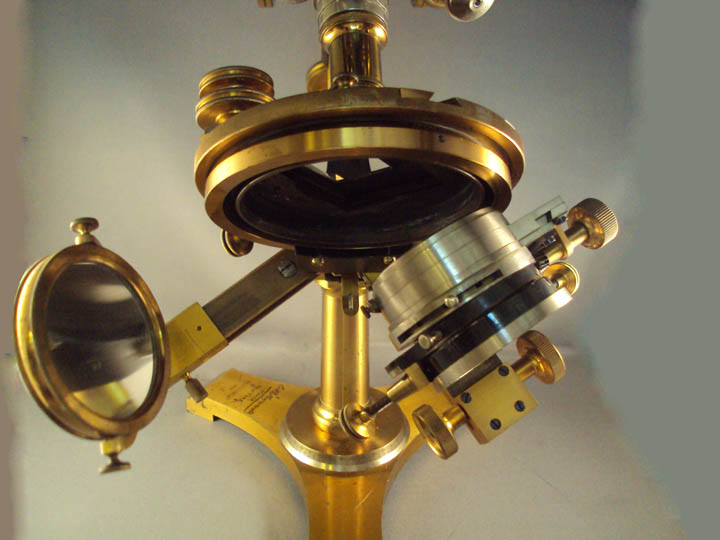 The complex substage of this microscope allows many different types of adjustments. Bulloch's microscopes were always touted for the double swinging substage arrangement, allowing not only oblique lighting by swinging the substage, but
the ability to separately swing the mirror for oblique lighting without the condenser, or all the way above the stage for top lighting of opaque objects.
The condenser assembly cannot rotate above the stage.
The complex substage of this microscope allows many different types of adjustments. Bulloch's microscopes were always touted for the double swinging substage arrangement, allowing not only oblique lighting by swinging the substage, but
the ability to separately swing the mirror for oblique lighting without the condenser, or all the way above the stage for top lighting of opaque objects.
The condenser assembly cannot rotate above the stage.
Scroll down for more images of the substage mechanisms.
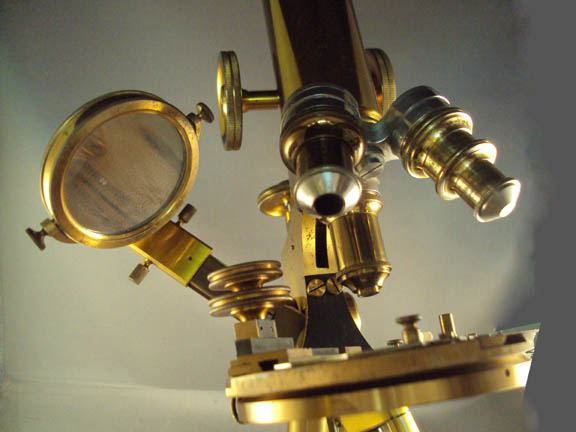 The mirror can be swung in an arc from directly below the substage to above the stage
for lighting opaque objects. There is a 'clickstop' for the vertical position, and also a catch that aligns the mirror with the condenser arm if desired.
The mirror can be swung in an arc from directly below the substage to above the stage
for lighting opaque objects. There is a 'clickstop' for the vertical position, and also a catch that aligns the mirror with the condenser arm if desired.
Scroll down for more images of the substage mechanisms.
 The substage condenser assembly can also rotate but not to above the stage.
The substage condenser assembly can also rotate but not to above the stage.
Scroll down for more images of the substage mechanisms.
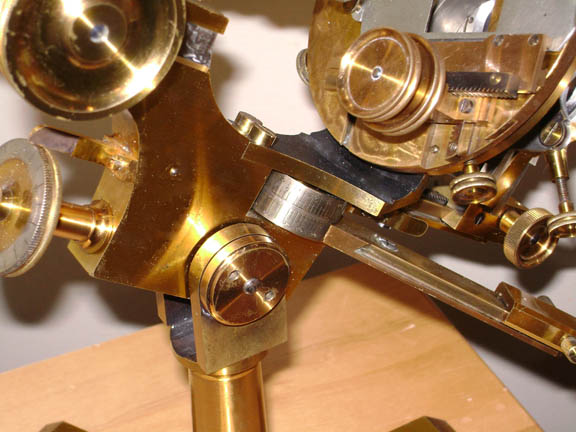 Both have calibrated silvered scales. The swinging action is supported via an axle
which does not go through the stage; the stage itself is supported separately by a 'saddle fitting' in the shape of an 'L';
this idea of Bulloch was promulgated with the idea that if the axle of rotation was not attached to the stage, rotation of the substage
would be less likely to disturb the specimen being examined.
Both have calibrated silvered scales. The swinging action is supported via an axle
which does not go through the stage; the stage itself is supported separately by a 'saddle fitting' in the shape of an 'L';
this idea of Bulloch was promulgated with the idea that if the axle of rotation was not attached to the stage, rotation of the substage
would be less likely to disturb the specimen being examined.
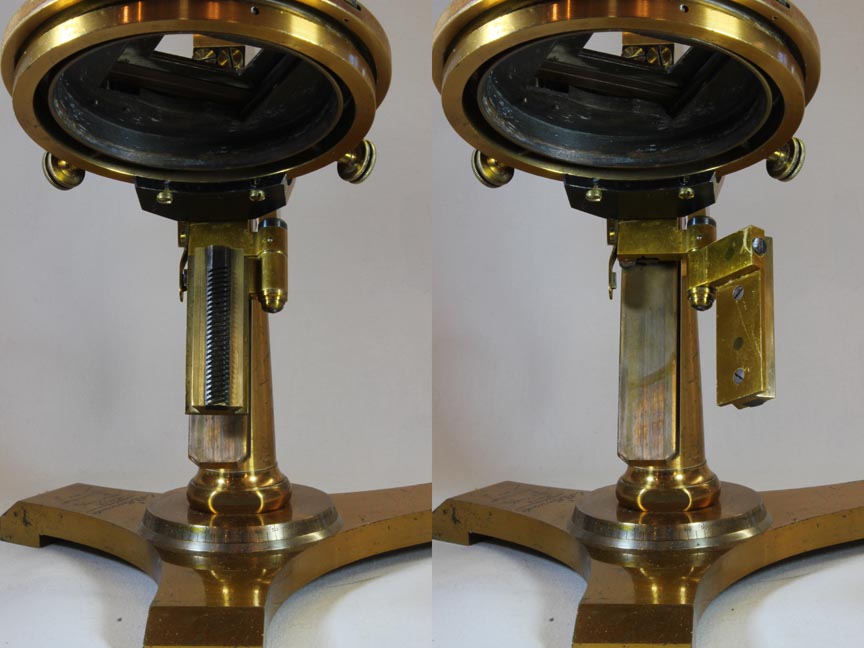
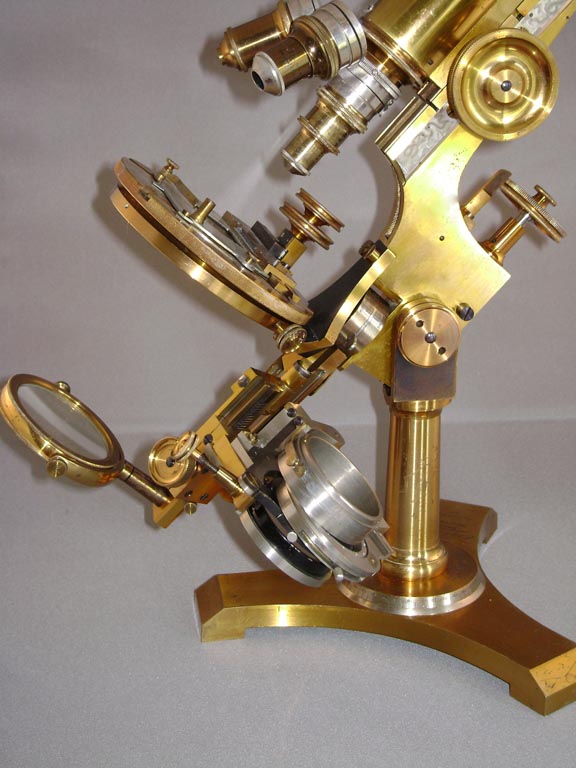
The entire substage condenser assembly can rotate out of the optical axis on a hinge. Note the spring catch that holds the entire assembly
in the optical axis; it uses the slot in a screw as a registration point. There is a similar mechanism just for the top part housing the condenser as shown in the next paragraph below.
Scroll down for more images of the substage mechanisms.
This substage, specifically designed for his
'Biological' microscopes, was devised by Bulloch and was well described in the JRMS in 1884, page 279 of Vol IV, Series 2.
As it states:
The tailpiece supporting the condenser assembly was now modified so that the entire assembly is hinged onto the tailpiece which carries it (shown in paragraph above).
It mentions that the substage rings are made in two parts and that the lower one can swing out independently; it was suggested that a polarizer
could be fitted to the lower ring, while a condenser was in the upper, and the filter ring between
them could house a filter or a stop. This arrangement could give the microscopist every facility... Without removing a single accessory he would be
prepared to use the light directly from the mirror by turning the substange aside...the condenser could be brought into use by a single motion, and the
different effects of oblique light and dark-ground illumination obtained by the simplest possible operation of changing diaphragms. Note the spring catch that holds the condenser assembly
in the optical axis; it uses the slot in a screw as a registration point.
By bringing in the polarizer, which is always ready for use, all the effects of polarized light can be obtained
as well.
This substage is even more advanced, than as originally described above, with an iris diaphragm under the top condenser ring and this iris
can be offset by a rack and pinion. Notice that the knob that controls this motion is not like the other controls of this stand;
likely this was a Meyrowitz addition to compete with a similar mechanism found on German and American microscopes. The ability to
offset an iris condenser for oblique lighting, soon replaced the swinging substage completely in microscopes so equipped. The presence of two
ways to produce oblique illumination, namely both the swinging substage, and the rack & pinion-controlled offset of the iris, is a feature not
often seen on any microscope and seems to provide the user with a choice of either the older or newer method. It should be noted, however that the B & L version is much more sturdy and made of heavier material.
This B & L assembly can be seen on the CCDS model seen in this collection. The Views shown below include a Condenser and a polarizer in the positions described in the JRMS article quoted,
to illustrate what was referred to. Neither of these are original to this instrument.
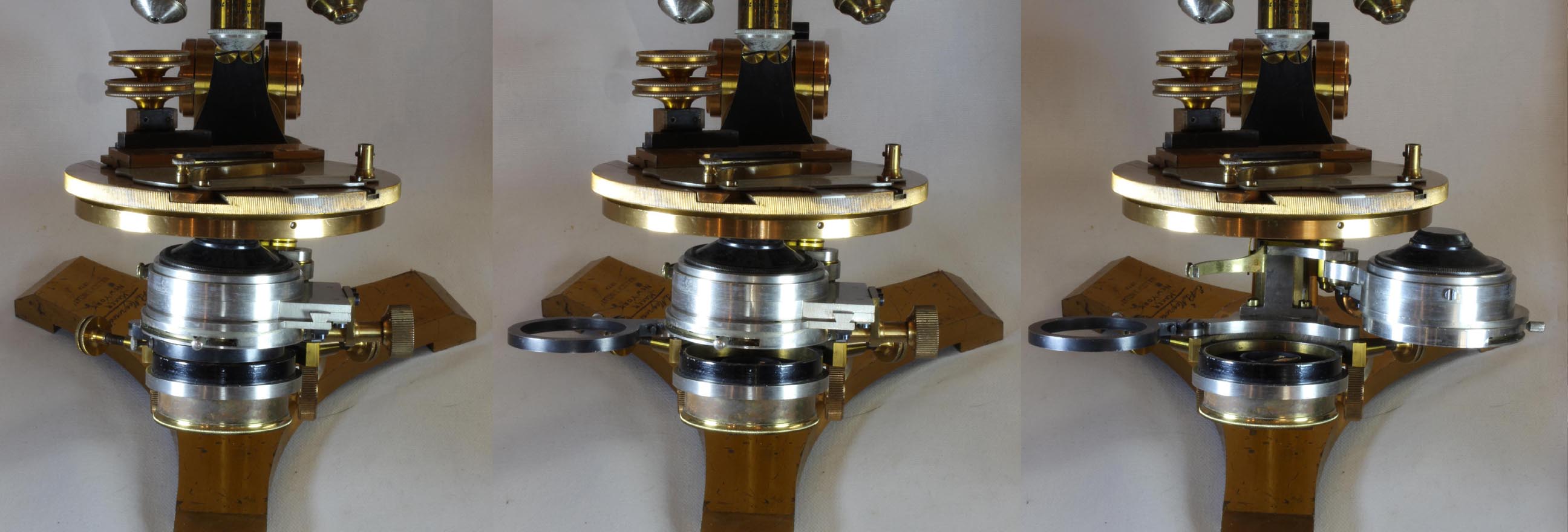
 The complex substage of this microscope allows many different types of adjustments. Bulloch's microscopes were always touted for the double swinging substage arrangement, allowing not only oblique lighting by swinging the substage, but
the ability to separately swing the mirror for oblique lighting without the condenser, or all the way above the stage for top lighting of opaque objects.
The condenser assembly cannot rotate above the stage.
The complex substage of this microscope allows many different types of adjustments. Bulloch's microscopes were always touted for the double swinging substage arrangement, allowing not only oblique lighting by swinging the substage, but
the ability to separately swing the mirror for oblique lighting without the condenser, or all the way above the stage for top lighting of opaque objects.
The condenser assembly cannot rotate above the stage.  The mirror can be swung in an arc from directly below the substage to above the stage
for lighting opaque objects. There is a 'clickstop' for the vertical position, and also a catch that aligns the mirror with the condenser arm if desired.
The mirror can be swung in an arc from directly below the substage to above the stage
for lighting opaque objects. There is a 'clickstop' for the vertical position, and also a catch that aligns the mirror with the condenser arm if desired.
 The substage condenser assembly can also rotate but not to above the stage.
The substage condenser assembly can also rotate but not to above the stage.  Both have calibrated silvered scales. The swinging action is supported via an axle
which does not go through the stage; the stage itself is supported separately by a 'saddle fitting' in the shape of an 'L';
this idea of Bulloch was promulgated with the idea that if the axle of rotation was not attached to the stage, rotation of the substage
would be less likely to disturb the specimen being examined.
Both have calibrated silvered scales. The swinging action is supported via an axle
which does not go through the stage; the stage itself is supported separately by a 'saddle fitting' in the shape of an 'L';
this idea of Bulloch was promulgated with the idea that if the axle of rotation was not attached to the stage, rotation of the substage
would be less likely to disturb the specimen being examined.

